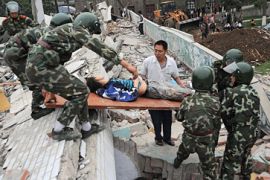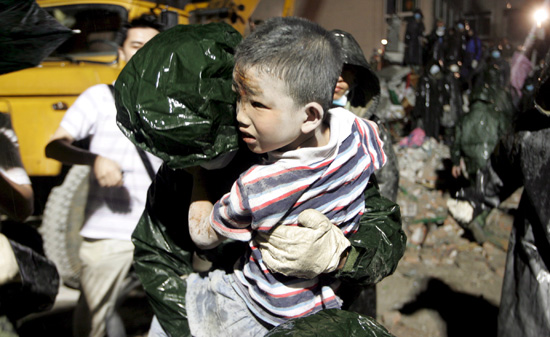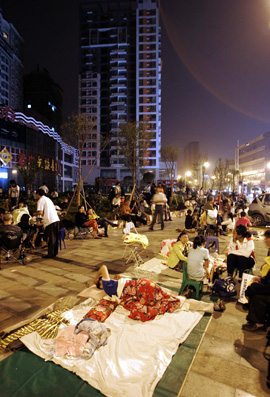Race to reach China quake survivors
Rescue workers dig through tonnes of rubble as death toll hits at least 10,000.

 |
| Hundreds of children have been trapped in collapsed schools across the disaster zone [EPA] |
Rescue workers in southwestern China are racing to dig out survivors from the rubble left by a powerful earthquake that has killed at least 10,000 people.
The death toll is expected to rise significantly as thousands of people are believed to be trapped under debris and many of the worst-hit areas are still cut off by landslides, officials have said.
| In depth: China quake | |
Pictures: Quake leaves devastation |
At least 10,000 people are believed to be trapped under the remains of collapsed buildings in the city of Mianzu near the quake epicentre alone, China‘s Xinhua news agency reported on Tuesday.
The magnitude 7.9 quake which struck on Monday was the most powerful to hit China in three decades.
The first tremor hit at 2:48pm local time (06:28 GMT) with its epicentre 92km northwest of Chengdu, the capital of Sichuan province.
A series of aftershocks rocked the region in the following hours.
Many of the victims were schoolchildren who were in class at the time the quake hit.
In the city of Dujiangyan close to the epicentre, rescuers were digging through the remains of a school, trying to locate 900 children who were in the building when it collapsed.
Al Jazeera correspondent Melissa Chan said that at one collapsed school outside of Chengdu the bodies of at least 200 children had been pulled from the rubble.
Many other areas, including the county of Wenchuan, close to the epicentre and with a population of about 100,000 people, remain cut off by landslides.
‘Urgent need’
 |
| In Chengdu many spent the night outdoors fearing further aftershocks [AFP] |
Large boulders and felled trees have blocked roads to the area.
A local official used a satellite phone to appeal for emergency aid, Xinhua reported.
“We are in urgent need of tents, food, medicine and satellite communications equipment through air drop,” the news agency quoted Wang Bin, the Communist Party secretary of the county, as saying.
“We also need medical workers to save the injured people here.”
Hundreds of people were buried and more than 6,000 evacuated after two chemical plants collapsed in the industrial city of Shifeng.
The collapse triggered a spill of about 80 tonnes of toxic ammonia.
Casualties have also been reported in the municipality of Chongqing, home to some 30 million people, which borders Sichuan province.
The massive Three Gorges Dam, located several hundred kilometres to the west of the quake zone was not damaged, officials have said.
The United States, the European Union, Russia and Japan have all offered sympathy and pledges of help.
However, Sean McCormack, the spokesman for the US state department, said China had not yet made any requests for international help.
Taiwan has also offered to send emergency aid and rescue workers.
Soldiers deployed
| Key earthquake facts |
|
About 1.4 million earthquakes occur every year – 100 of which cause damage on average. Predicting the outcome of earthquakes is impossible, although mapping their geographical likelihood is feasible. The “Ring of Fire” – a horseshoe-shaped band of volcanoes and fault lines circling the edges of the Pacific Ocean – is where most of the largest earthquakes happen. Central China suffered the world’s deadliest recorded earthquake, which killed about 830,000 in 1556. The largest recorded earthquake was in Chile in 1960. It measured 9.5 on the Richter scale. Quakes generally occur at depths of less than 80km from the Earth’s surface. Evidence of earthquakes date back to 1831BC, in China’s Shandong province. Source: The US Geological Survey |
About 20,000 police and soldiers have been deployed to the disaster area, with Wen Jiabao, the Chinese premier, in the region to oversee recovery efforts.
“The situation is worse than we previously estimated and we need more people here to help,” he said at the emergency co-ordination centre.
“So long as there’s a glimmer of hope, we will make every effort. We will not rest.”
Hu Jintao, the Chinese president, has called for an “all out” effort to rescue victims.
Monday’s initial quake lasted for several minutes and was powerful enough to be felt across several cities in South-East Asia, including Bangkok, the Thai capital, more than 1,800km from the epicentre.
In Beijing, the Chinese capital, and Shanghai, office workers poured into the streets as the tremor hit.
There was no visible damage in Beijing, which will hold the summer Olympics in August, Xinhua said.
China‘s deadliest quake in recent memory hit the eastern city of Tangshan in 1976.
The magnitude 7.8 earthquake was followed by an equally powerful aftershock almost a day later; together they killed around 240,000 people.
